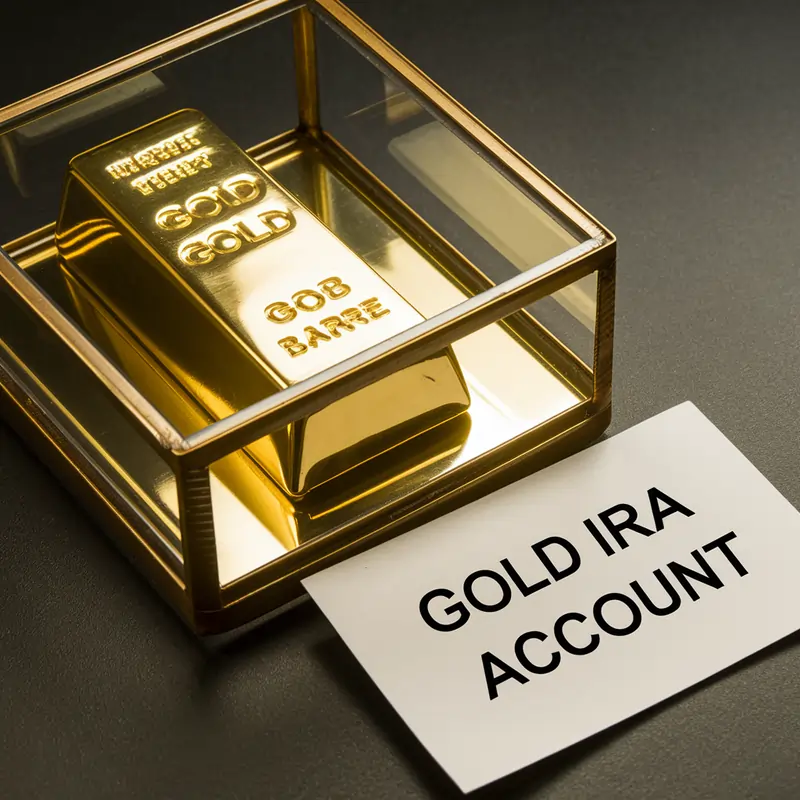
Discover how a gold IRA account can turn your retirement dreams into reality! Unleash the power of gold investments today.

Table of Contents
Gold IRA Account: Understanding Gold IRAs
When it comes to securing my retirement and adding luxury to my golden years, one investment option that stands out is a Gold IRA account. Let me introduce you to the world of Gold IRAs and shed light on the tax differences that come with this unique investment vehicle.
Introduction to Gold IRAs
A Gold Individual Retirement Account (IRA) offers a distinctive way to diversify my retirement portfolio by holding physical gold. As shared by CBS News, a gold IRA allows me to add gold to my investment mix while enjoying the tax advantages that traditional IRAs provide. This means that not only am I investing in a tangible asset with intrinsic value, but I am also benefiting from tax-deferred growth on my investment.
With a Gold IRA, I have the ability to hold physical metals such as bullion or coins, along with precious metals-related securities within my retirement account. This type of IRA can be set up using pretax funds or as a Roth IRA, funded with post-tax money. The Internal Revenue Service (IRS) permits holders of self-directed IRA accounts to acquire bars and coins minted from gold or other approved precious metals.
Tax Differences in Gold IRAs
The tax treatment of Gold IRAs differs based on whether you opt for a traditional or Roth IRA structure. In a traditional Gold IRA, funds are taxed upon withdrawal, determined by the tax rate applicable at retirement. On the other hand, a Roth Gold IRA taxes funds at the time of contribution, based on the current tax rate. This tax distinction can have implications on my overall investment strategy and retirement income planning.
Understanding the tax implications of my Gold IRA is essential in making informed decisions about my retirement savings. Whether I choose a traditional or Roth Gold IRA, the ability to invest in physical gold within a tax-advantaged retirement account offers a unique opportunity to safeguard my financial future and enjoy the potential benefits of investing in this precious metal.
Exploring the benefits and tax considerations of a Gold IRA is just the beginning of a journey towards a secure and prosperous retirement. As I delve deeper into the intricacies of managing a Gold IRA, I will uncover further insights into how this investment vehicle can pave the way for a financially sound future.
Gold IRA Account: Setting Up a Gold IRA
When considering the practical steps of setting up a Gold IRA, there are key aspects to understand that can pave the way for a secure retirement. Let’s explore the benefits of self-directed IRAs, the process of opening a Gold IRA account, and the contribution limits and withdrawal regulations that come with this investment option.
Benefits of Self-Directed IRAs
One of the notable advantages of a Gold IRA is the option to opt for a self-directed IRA. This type of IRA allows individuals to diversify their investment portfolio by including IRS-approved metals and tangible assets like gold. This diversification strategy serves as a safeguard against inflation and economic uncertainties.
By having the autonomy to choose alternative investment options beyond stocks and bonds, individuals can tailor their retirement savings to align with their financial goals and risk tolerance. Self-directed IRAs offer the flexibility needed to explore different avenues for wealth preservation and growth.
Process of Opening a Gold IRA
The process of opening a Gold IRA account is typically straightforward and user-friendly. Completing the application usually takes approximately 10 to 15 minutes, and in most cases, the account can be opened within one business day. However, the duration of funding your account may vary depending on the chosen method.
To initiate the process, individuals are required to choose a reputable custodian specializing in Gold IRAs and submit the necessary paperwork for account setup. Once the account is established, funding can be done through various means, such as transfer, rollover, or direct contribution.
Contribution Limits and Withdrawals
Understanding the contribution limits and withdrawal rules associated with a Gold IRA is essential for effective retirement planning. In 2023, the contribution limit for a Gold IRA stands at $6,500, increasing to $7,000 in 2024. Individuals aged 50 or older have the option to make an additional catch-up contribution of $1,000 in both 2023 and 2024 (Investopedia).
It’s important to adhere to these limits to stay compliant with IRS regulations and maximize the tax benefits that come with contributing to a Gold IRA. Withdrawal rules can vary based on the nature of the IRA account (traditional or Roth), and early withdrawals may incur penalties, so it’s advisable to consult with a financial advisor to strategize the most optimal withdrawal plan.
By comprehending the benefits of self-directed IRAs, the steps involved in opening a Gold IRA, and the contribution limits and withdrawal guidelines, individuals can embark on the journey of securing a stable and prosperous retirement nest egg. A Gold IRA offers a distinctive pathway to fortify retirement savings, safeguard against inflation, and diversify investment holdings for long-term financial security.
Gold IRA Account: Investing in a Gold IRA
When it comes to gold IRA accounts, understanding the investment options, storage requirements, and associated fees is crucial for making informed decisions about your retirement savings.
Investment Options in Gold IRAs
One of the key advantages of a gold IRA is the ability to diversify your retirement portfolio by holding physical metals like bullion or coins, as well as precious metals-related securities. By incorporating gold into your investment mix, you can potentially hedge against market uncertainties and protect your wealth in times of economic instability.
With a self-directed IRA, you have the flexibility to invest in IRS-approved metals and tangible assets, including art, collectibles, and real estate. This allows you to tailor your portfolio to suit your risk tolerance and financial goals, providing a level of control and customization not typically found in traditional retirement accounts.
Storage and Custodian Requirements
Investing in a gold IRA necessitates storing physical metals, which requires the services of a custodian to ensure compliance with IRS regulations. These custodians, often banks or brokerage firms, play a crucial role in managing the account and safeguarding your precious metal holdings.
It is essential to store gold and silver acquired through a precious metals IRA with an approved bank or depository to adhere to IRS guidelines. Self-storage options may lead to legal issues and potential IRS penalties or fines, highlighting the importance of working with a reputable custodian to properly manage your assets (LendEDU).
Fees Associated with Gold IRAs
Compared to traditional IRAs, gold IRAs typically come with higher fees due to the nature of purchasing and storing physical metals. The costs associated with owning a gold IRA include custodial fees, storage fees, and potentially higher transaction fees.
Investors leveraging gold IRAs should factor in these expenses when evaluating the overall performance of their retirement portfolio. While the fees may be higher, the potential benefits of incorporating gold into your investment strategy, including diversification and protection against inflation, can outweigh the associated costs.
Before diving into a gold IRA investment, conducting a thorough cost-benefit analysis is recommended. Understanding the fees involved and weighing them against the potential risks and rewards can help you make informed decisions about whether a gold IRA aligns with your retirement objectives. Consider consulting with reputable gold IRA companies to explore your options and tailor a gold IRA solution that fits your financial aspirations.
Gold IRA vs. Traditional Investments
When evaluating the choice between a Gold IRA and traditional investments, it’s essential to consider the aspects of portfolio diversification, potential returns, as well as volatility and long-term performance.
Portfolio Diversification with Gold
One of the key advantages of including gold in a retirement portfolio, such as a Gold IRA, is the diversification benefits it offers. Gold, being a tangible asset, doesn’t move in direct correlation with stock or bond markets (USA Today). This lack of correlation can help reduce overall portfolio risk, particularly during turbulent economic times or market fluctuations. By adding gold to your investment mix, you can potentially mitigate losses from other assets in your portfolio during market downturns.
Potential Returns of Gold IRAs
While gold is recognized as a stable investment, its potential returns may not be as high as riskier assets like stocks or bonds. The returns on a Gold IRA are influenced by factors such as capital growth and the timing of your investments (USA Today). It’s important to understand that gold typically doesn’t yield high returns compared to other investment options. However, its stability and potential to appreciate can provide a counterbalance to the overall risk exposure in your retirement portfolio.
Volatility and Long-Term Performance
Gold IRAs serve as a vital component of diversification within a retirement account, acting as a hedge against economic uncertainties. When comparing the volatility and long-term performance of gold in a retirement portfolio to traditional investments, gold often demonstrates more stable performance. It tends to hold its value well over the long term, offering a level of security and stability that can be beneficial during market downturns.
In conclusion, although gold may not provide the highest returns compared to traditional investments, its stability and potential for appreciation make it a valuable asset in a retirement portfolio. By carefully assessing the role of gold in your investment strategy, considering factors like risk tolerance and growth objectives, you can make an informed decision on whether to include gold in your retirement accounts. For more information on the best gold IRA companies and gold-backed IRAs, check out our comprehensive guides on best gold IRA companies and gold-backed IRAs.
Gold IRA Account: Advantages of Including Gold in Retirement
When it comes to securing a luxurious retirement, gold IRA accounts play a vital role in diversifying and safeguarding your financial future. Let’s delve into the key advantages of incorporating gold within your retirement investment strategy.
Inflation Hedge and Diversification
Gold has a long-standing reputation as a reliable hedge against inflation, making it an attractive asset to counteract the effects of inflation on traditional currencies (USA Today). By including gold in your retirement portfolio, you can shield your wealth from the erosive impact of rising prices, preserving the purchasing power of your savings over time.
Moreover, gold offers effective diversification benefits, as its value does not move in direct correlation with stock or bond markets. This lack of correlation helps reduce the overall risk within your investment portfolio, providing stability and resilience during fluctuations in the financial markets.
Stability in Economic Uncertainty
During times of economic instability, gold shines as a beacon of stability and security within a retirement portfolio. Its intrinsic value and practical applications across industries such as medicine, electronics, and space exploration lend it a unique resilience that transcends market fluctuations. By owning gold in your IRA, you can navigate uncertain economic conditions with confidence, knowing that your wealth is shielded from external pressures.
Tax Advantages and Portfolio Strategies
Gold IRAs provide tax advantages akin to traditional IRAs, offering a tax-efficient way to grow your retirement savings (USA Today). Within a gold IRA, any profits generated from the appreciation of your gold investments are not immediately subject to taxation. This tax-deferred growth allows your retirement funds to compound over time without the burden of immediate tax implications, maximizing the growth potential of your investments.
By strategically integrating gold into your retirement portfolio, you can enhance your wealth preservation efforts, mitigate risk, and capitalize on the unique benefits that gold offers as a tangible and enduring asset. With its ability to hedge against inflation, provide stability during economic turbulence, and offer tax advantages, gold proves to be a valuable addition to your retirement planning arsenal.
Gold IRA Account: Practical Considerations for Gold IRAs
When considering gold IRA accounts as part of your retirement strategy, it’s essential to weigh the cost-benefit analysis, understand potential risks and rewards, and assess gold as a valuable asset for your retirement portfolio.
Cost-Benefit Analysis
Gold IRAs come with various fees, including setup fees, storage fees, and transaction fees, which can be higher compared to traditional IRA accounts, potentially impacting the overall return on investment. Before opening a gold IRA, it’s crucial to evaluate these fees and consider how they may affect your investment goals (LendEDU).
To provide a clearer perspective, consider the table below outlining the potential fees associated with gold IRAs:
| Fee Type | Description |
|---|---|
| Setup Fees | Fees to establish a gold IRA account |
| Storage Fees | Costs for storing physical gold |
| Transaction Fees | Charges related to buying/selling gold |
Potential Risks and Rewards
Investing in gold IRAs presents both risks and rewards that investors need to consider. While gold is often viewed as a safe-haven asset, its price can be subject to fluctuations in the market. Past performance does not guarantee future returns, thus conducting thorough research and understanding your risk tolerance is essential.
Gold as a Retirement Portfolio Asset
Gold, as a tangible asset, offers stability and security during economic uncertainties. The practical applications of gold in various industries, such as medicine, electronics, and space exploration, add to its intrinsic value. By including gold in your retirement portfolio, you can hedge against inflation, diversify your investments, and benefit from its role as a store of value.
As you evaluate the role of gold within your retirement strategy, keep in mind the potential benefits and risks associated with gold IRAs. By conducting a thorough cost-benefit analysis, considering the potential risks and rewards, and recognizing the value of gold as a retirement asset, you can make informed decisions that align with your long-term financial goals.
Related Post:
-

Madrid’s Hidden Fashion House: Where True Luxury Whispers
-

Monaco Unveiled: A Billionaire’s Playground for the Ultimate Luxury Escape
-

Empowering My Wealth: How a Gold-Backed IRA Benefits Me
-

Turning Dreams to Gold: How a Gold IRA Account Paves the Way
